
I’m back.
I’ve returned from walking the Camino de Santiago, a medieval Christian pilgrimage in northern Spain. Today, many non-Christians walk it as well.
I wrote about it before I left, explaining that I was looking for a spiritual and physical journey. I hoped for an adventure. I got one.
Here’s a written snapshot of my experience, along with a few things I’ve learned, some financial stuff (of course), and advice to anyone else who desires to walk the Camino. For those wanting more, check out the daily journal I wrote on Facebook. I highlight some of those entries here.
🥾🥾🥾🥾🥾
May 25th, Saint-Jean-Pied-de-Port, France
The night before we set out, we went to the evening service at the old church in Saint Jean for the pilgrim’s blessing. It was cool and drizzly outside, and the town was pretty buttoned up (I learned that many things are closed on Tuesdays around here). The French-speaking priest asked us all to come forward, and about 20 of us approached him. We comprised 80% of the congregation that night. He asked us where we were from. “Sweden.” “Canada.” “Poland.” “America.”
He then prayed over us, and here is part of his blessing in English:
Almighty God, you are always kind to the ones who love you and open to the ones who seek you with a sincere heart.
Have mercy on your servants who are making this pilgrimage and lead their paths according to your will.
Be their shade in the heat of the day and be their relief when they get exhausted.
Grant them the courage to accomplish their walk under your protection through our Lord, Jesus Christ.
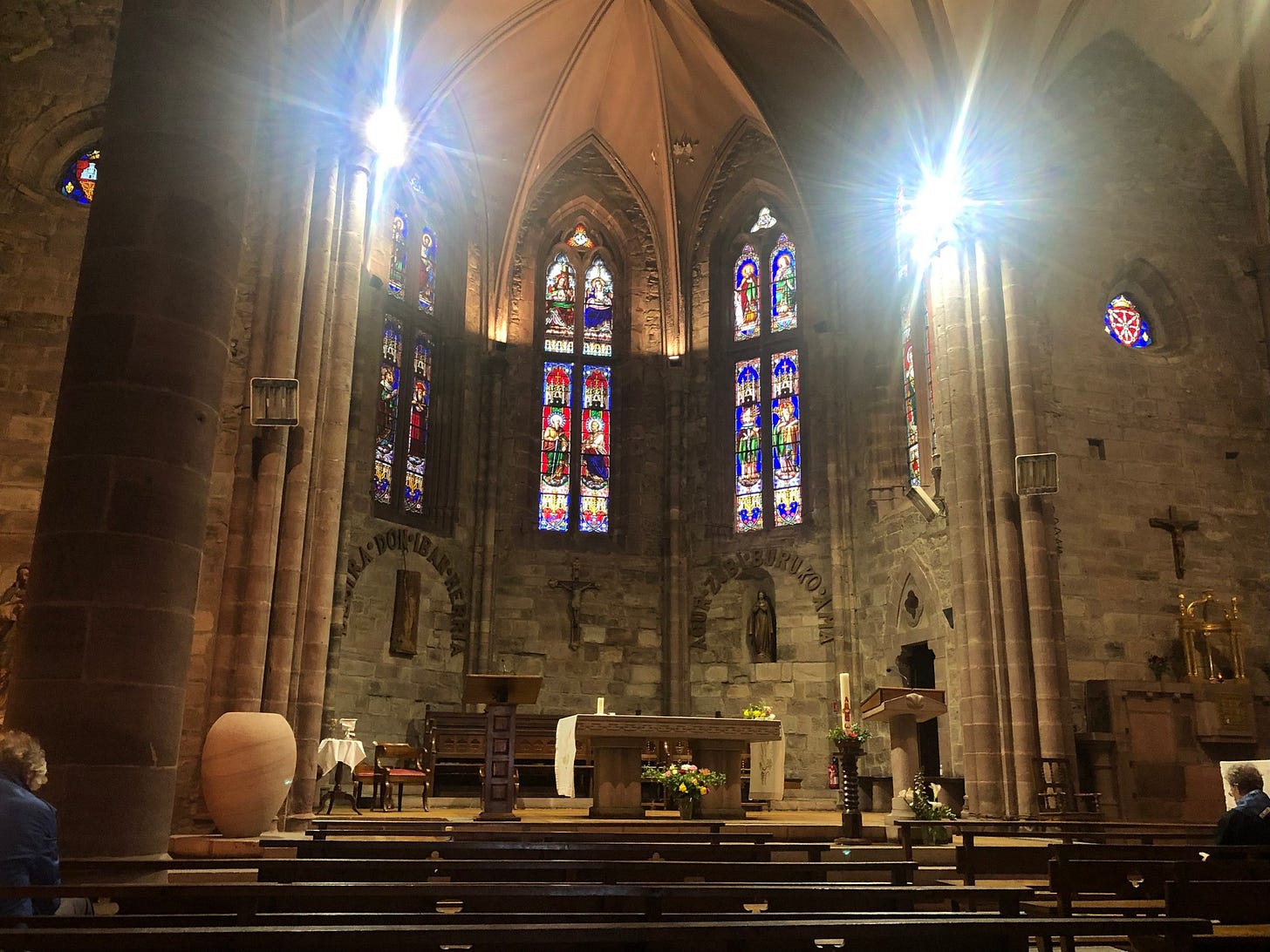
The church in Saint-Jean-Pied-de-Port before mass on May 24th.
I Made it!
First, let’s cut to the ending. I walked nearly 500 miles across Spain. Every step. It took me 31 days. I credit good shoes, good socks, good training, good company, lots of prayers, more than a little Rioja, and the occasional aspirin.
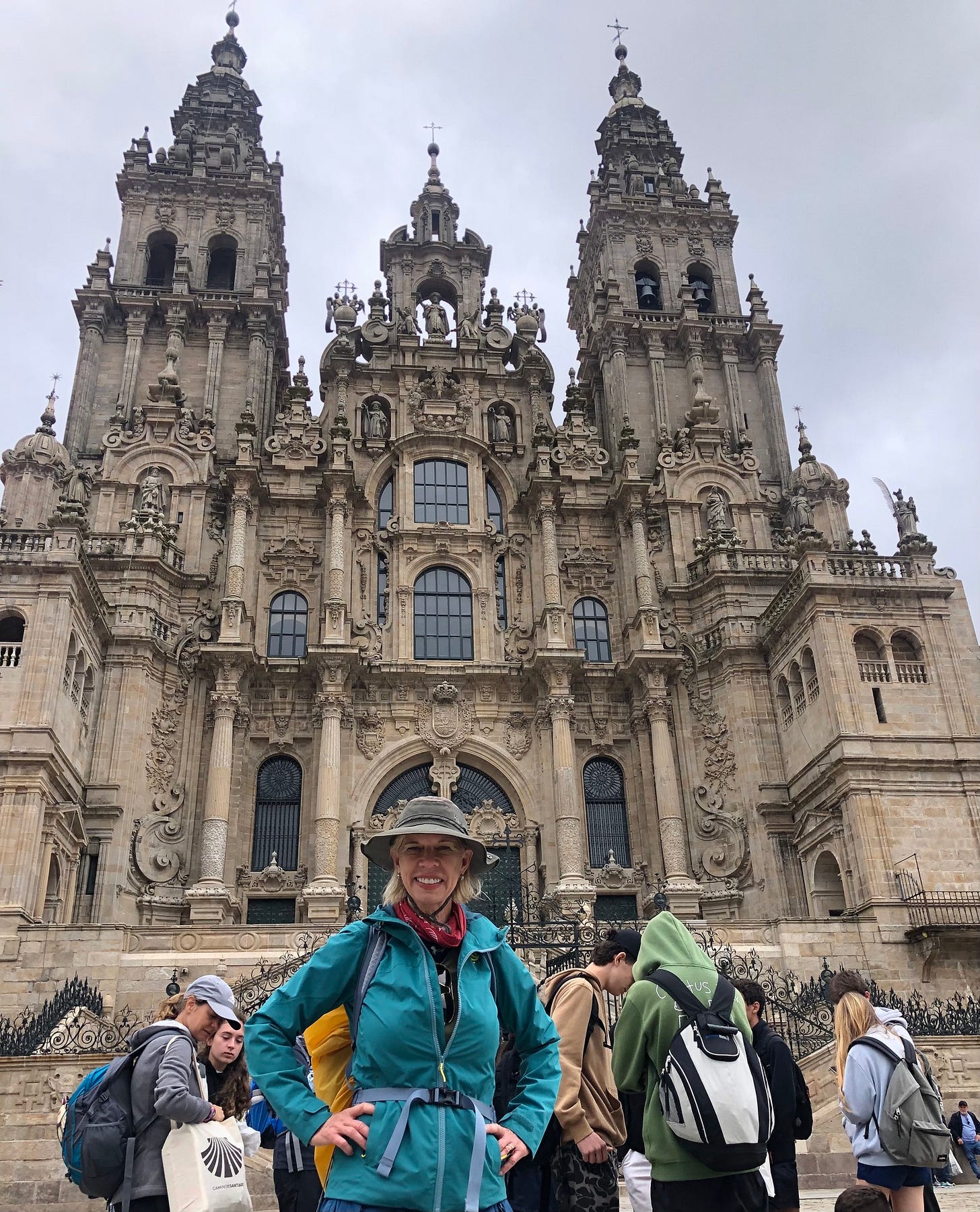
Outside the cathedral in Santiago de Compostela, June 24th.
Along the way, I learned two things:
— If you spend several hours a day walking in nature with your phone turned off, you will be better for it.
— Spain is the world’s best travel value right now.
Okay, I learned a third thing: There’s no bad wine in Spain.
I began the Camino de Santiago in Saint-Jean-Pied-de-Port, France, on May 25th. That was the morning after the school shooting in Uvalde, Texas.
I ended the journey in Spain on June 24th by entering the cathedral of Santiago de Compostela. That was the same day the U.S. Supreme Court overturned Roe v. Wade.
It was a good time to be gone.
America is going through a tough time, and so is much of the planet. But times have always been tough, generally speaking. History is one long and sad story.
However, the Camino proves there’s also kindness and beauty to be found if you let down your guard. Exhaustion lowers that guard. It allowed me to meet some amazing people along the Camino. Everyone walks for their own reasons, or no reason at all.
🥾🥾🥾🥾🥾
Day 13
I asked her what she’d done before retirement. She’d been a military officer, a reservist activated after 9/11. She’d been sent to Afghanistan, and then for nearly a year she was stationed at Gitmo… providing medical care for the detainees.
“I bet you have stories to tell,” I said.
“It was worse than Afghanistan,” she told me quietly.
“She doesn’t talk about it,” said her husband.
——
Day 16
At breakfast we met Tom, a small business owner from New Jersey. Looks to be in his early 60s. I asked him why he’s walking the Camino.
“I don’t really know,” he said. “I have some canned answers if you’d like to hear.”
“Yes, tell me your lies,” I responded, and we both laughed.
🥾🥾🥾🥾🥾
Over the span of a month, I met dozens of pilgrims. Faces became familiar, and then became family.
I walked an average of 16 miles a day, but very few days were “average.” There were long days hiking over steep hills. It never got easier. Yet I’m already missing the routine: Up early to start trekking at dawn, stopping somewhere for coffee and toast, arriving at my destination hours later, relaxing with a beer and a sandwich of jamón y queso, taking a siesta — the traditional afternoon nap — before heading to dinner (Spaniards don’t eat until after 7:30p), and then to bed.
I had one job every day: Keep walking to the next stop. It wasn’t complicated. I didn’t take time to catch up on “Stranger Things” or see the new “Top Gun.” I skipped the January 6th hearings. I checked the headlines at the beginning and the end of each day, but I spent most of my downtime lingering in cafes. I wrote. I read.

Sunrise outside Sarria, Spain, on June 21st.
🥾🥾🥾🥾🥾
Day 11
At the 7-mile mark we climbed into a forest. It was gorgeous. A paradise for butterflies. There were large white butterflies with black “veins” in their wings. Orange ones with dark polka dots. Pale blue butterflies looked almost purple when they took flight.
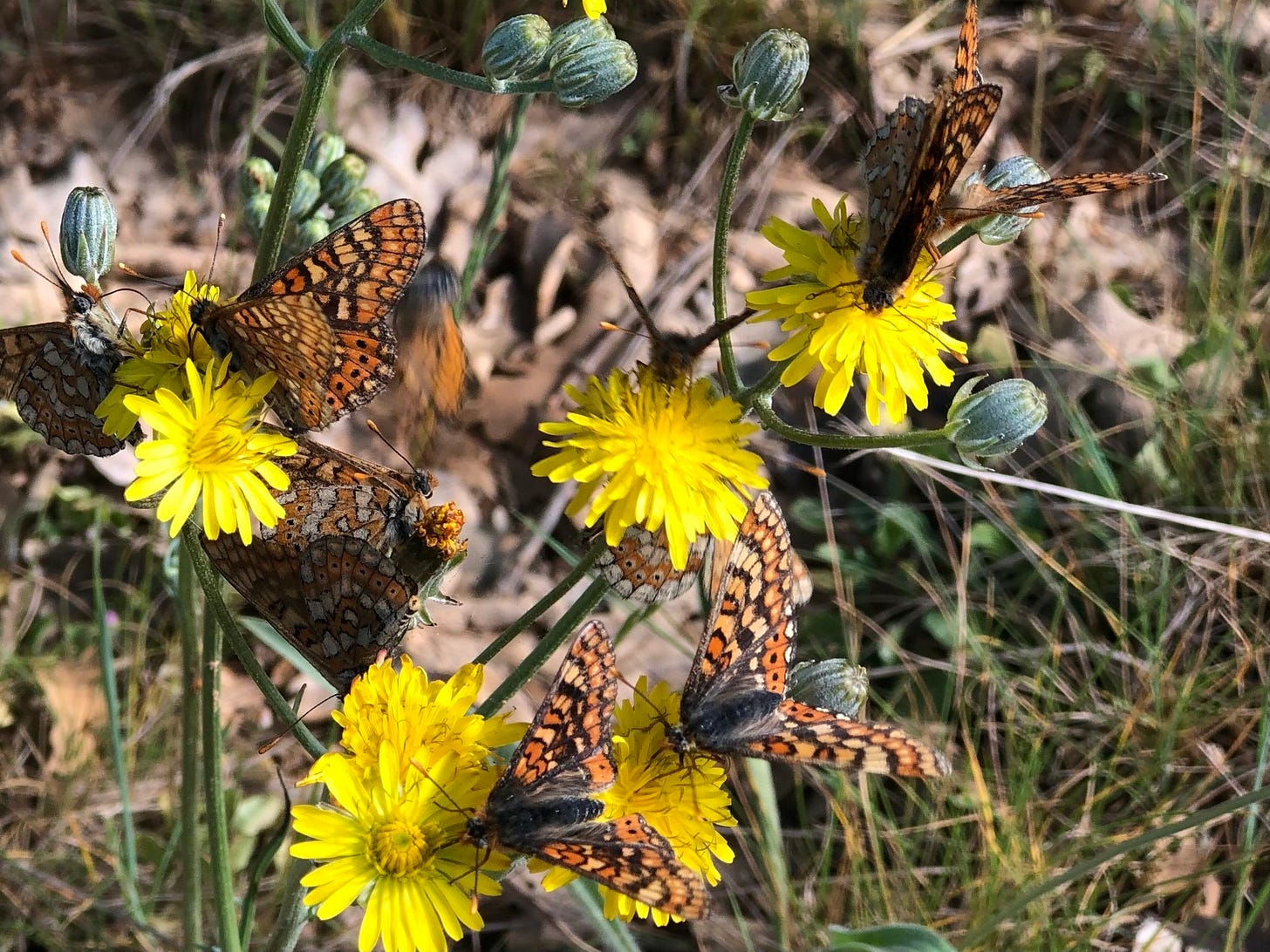
——
Day 14
Coming down from the one big hill today, I saw a yellow car driving up the Camino. At first I thought it was a taxi looking for people who were giving up (this happens). Instead, it was some sort of local police or civil patrol, stopping to ask everyone how they’re doing. They did the same with me, asking me if I had enough water, if I slept well, how far I was going.
🥾🥾🥾🥾🥾
I had a hiking buddy, which turned out to be a great blessing. For those of you who followed my daily Facebook journal, the hiking buddy was essential on Day 20. I won’t go into detail. It’s too embarrassing. #IYKYK.
Together we climbed the Pyrenees in a storm, and we crossed the flat plains of the Meseta in record-breaking heat. We outran a lightning storm by scrambling into a shelter that only had half a roof. We fled the “Hotel from Hell,” and we battled battalions of flies.
We hiked through vineyards, farms and forests. We joked about other pilgrims, and we thought about hunting down two of them, “G&B,” who insisted on defacing every sign with vapid “inspirational” messages scribbled in Sharpie. We didn’t, though, realizing that wouldn’t be very “Camino” of us…
We renamed a small town’s running of the bulls “the scampering of the bulls,” because most of the animals weren’t feeling it. We quoted a lot of Monty Python, and sometimes we said nothing at all.
We hardly bickered. We were too tired.
Here’s a bit of the scampering of the bulls in Sahagún, followed by one bull who was not happy.
🥾🥾🥾🥾🥾
Day 5
Yesterday I saw a man walking the Camino in the afternoon heat in a dress shirt and jeans. This morning I saw him again… dressed the same, but with a sport coat. I joked that maybe his boss doesn’t know he’s on the Camino, and he needs to be prepared to Zoom in.
——
Day 18
Then everyone went into the bull ring. There were no bullfights scheduled, but some of the drunken idiots chased a young bull around until the bull got sick of it and gored one of them. The guy’s fine. I guess.
——
Day 21
As I was walking down the hill into Astorga, a man played guitar on the side of the Camino. He was making up songs, and as I started dancing a little, he sang in Spanish about “la peregrina” (the female pilgrim). He asked me for “an American dollar.” When I told him I didn’t have one, he started singing about the peregrina who wouldn’t give him a dollar.
🥾🥾🥾🥾🥾
Following the Money for a Millennium
The Camino has been a moneymaker in Spain for over a thousand years. It started when Christian relics — parts of the cross, the crown of thorns, or the bones of saints — were all the rage throughout medieval Europe.
Enter Saint James (“Santiago” in Spanish). James was one of the earliest disciples of Jesus and the first to be martyred. Legend has it that he traveled to Spain to spread the Good News, and after he was beheaded by Herod Agrippa in Jerusalem, two of James’ followers brought his body back to Spain for burial.
Cut to the 9th Century. A local hermit in the area of what is now Santiago de Compostela saw lights glimmering in an oak grove and found what he believed to be James‘ bones. The hermit told the local bishop about his discovery, and the bishop confirmed his findings. A local king was soon on board, and a church was eventually built to house the bones.
Soon, people were traveling to see the remains of James, walking through the plains of Spain (like Jane, through rain). Businesses popped up to house and feed these medieval pilgrims. Then James got a new nickname, as Christians battling Muslims across the Iberian Peninsula were spurred to victory by the saint’s miraculous appearance. He morphed from being an Apostle to Protector of Pilgrims to “Santiago Matamoros,” or St. James, the Killer of Moors. It sounds like an odd progression, but hey, it was effective marketing.

One of the many small chapels and churches along the Camino.
The Camino is still a powerful draw today for a variety of reasons. (An article in one of the local newspapers said the hospitality industry is rejoicing over the return of pilgrims after two years of Covid.) As I wrote before I set out, there are many “caminos,” or ways, to Santiago de Compostela, but I chose to walk the Camino Frances, the “French Way.” It’s the most traditional and popular route. It also has the most infrastructure.
We budgeted $2,500 apiece for food and shelter over 31 days. We spent much less, under $2,000 each. Spain is cheap, and the dollar is strong.
Granted, we weren’t staying at five-star hotels. We mostly chose small private hostels called albergues. We avoided the super cheap municipal dorms with their bunk beds, though we occasionally still had to share a bathroom.
🥾🥾🥾🥾🥾
Day 29
The bar in Castromaior is run by two sisters, and they cook as if you were in their home. It was chilly last night, and their mother sat in the corner of the restaurant by a wood-burning fireplace. A cab driver regaled a few locals at the bar in between shots of limoncello. Other pilgrims hobbled in for dinner, doing what we call “The Peregrino Shuffle.”
——
Day 8
OMG OMG OMG OMG OMG OMG I’m not a huge mushroom person but this was the most delicious grilled mushroom/butter/salt/magic thingie on a piece of bread. I will be talking about that morsel for the rest of my life.
🥾🥾🥾🥾🥾
Food along the pilgrims’ path was often repetitive and merely sufficient. But it was occasionally fantastic, like the aforementioned mushrooms at Bar Soriano in Logroño, or the boiled octopus I tried in a food tent at a farmer’s market in Sarria. There were a few foul balls, like the time I ordered the local specialty, called “Botillo del Bierzo.” Google it. Don’t eat it.
The wine was always good. We drank mostly reds: Rioja Crianza and Ribera del Duero, though the Galician white, Ribeiro, was dry and refreshing. The reds are served chilled, and I got used to it, especially on a hot day. Most wines cost under $10 a bottle in grocery stores, and under $15 at restaurants. On our final night in Santiago, we “splurged” on a $30 bottle of 2018 Emilio Moro, 100% Tempranillo. Delicious.

The owners of Bar Soriano in Logroño, Spain. GO THERE.
My Advice for Future Pilgrims
Good shoes and socks are the most important investments you will make. We wore Altra Lone Peak trail runners (a half size larger than normal since our feet would swell) and Darn Tough socks. Neither one of us got a blister in 31 days. That’s a miracle, frankly, because some days were ridiculously long. One day we walked 26.2 miles. So stupid.
We followed a guidebook that apparently assumed we were triathletes or former Navy SEALs. We started to call it “The Book of Lies,” because every segment was about a mile longer and much more difficult than the book claimed it was. If I were to walk the Camino again, I would trek for 35–36 days instead of 31, and I would cover no more than 12–15 miles a day.
🥾🥾🥾🥾🥾
Day 14
I was getting really tired after the 20-mile mark, with my head down and putting one foot in front of the other. I was starting to wonder if I could keep walking. Then I heard a quiet, “Buen Camino,” and I looked up to see an old farmer smiling at me as he tended his vegetable garden. It gave me just the boost I needed.
——
Day 30
When the alarm went off at 5:30a, I could feel the previous two days of long walks all the way down to my toes. The hiking buddy broached the topic of spending $20 on a cab versus $30,000 on reconstructive foot surgery, but I refused to listen to such rational negativity! So we popped some aspirin and set out.
🥾🥾🥾🥾🥾
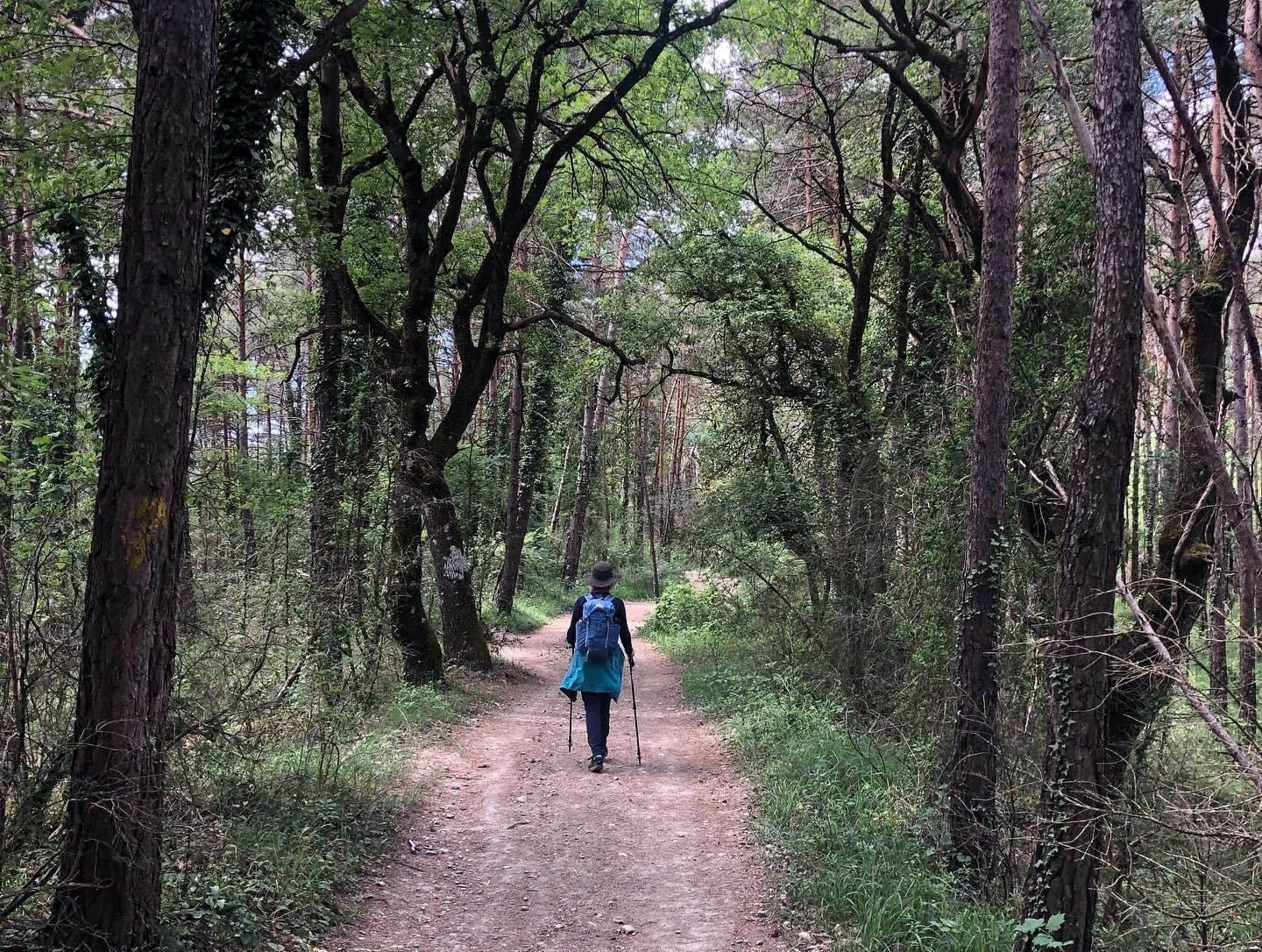
Somewhere between Espinal and Zubiri.
We did not carry full packs, and I have respect for those who do. The 12-pound daypack was heavy enough. We used a courier service called Camino Fácil to ship our full packs ahead every day to our next destination. I reserved private rooms through Booking.com.
Both Booking and the courier were great. The only drawback was that we were locked into staying where we’d booked, because that’s where our packs were going. There were times when we might’ve chosen to stay somewhere else. But the reservations paid off; other pilgrims who tried to find private rooms on the fly often had trouble securing lodging and were forced to stay in the municipal dorms.
One note about packing: If you’re interested in doing the Camino, put together everything you think you absolutely have to take, and then get rid of half of it. Wear one hiking outfit on the airplane (pants that convert to shorts, long-sleeved shirt, light fleece, hiking shoes, socks, and hat), and pack a second hiking outfit, plus an extra pair of socks and underwear, rain gear, sunglasses, and flip flops to wear when you take off your hiking shoes at the end of the day. That’s your wardrobe. Throw in the smallest sleeping bag you can find (you’re just throwing it on top of a bed to avoid bedbugs), plus a few toiletries like sunblock, a couple of water bottles, hiking poles, a little first aid, and a phone charger.
You can always buy something along the way if you need it.
You won’t need it.
So did the Camino change me?
Day 23
I stood at the foot of the cross in the predawn moonlight. In my pocket I held a rock I’d brought from home. This rock is an old piece of lava that I found on a beach on California’s Central Coast. It had been softened and rounded by the ocean. It was a piece of the Earth’s beginning.
🥾🥾🥾🥾🥾
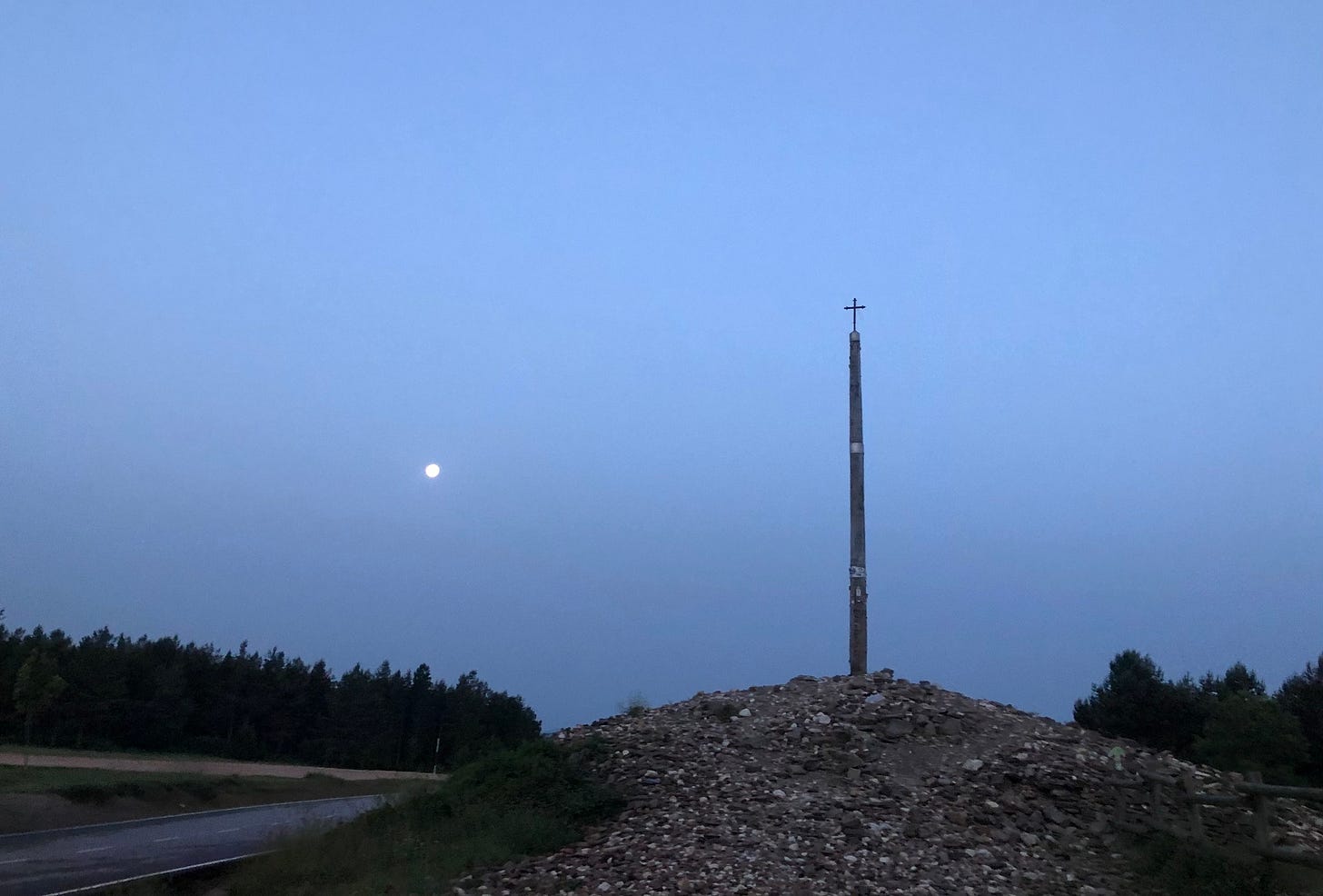
Cruz de Ferro, where pilgrims place rocks symbolizing a burden they leave behind.
The Camino calmed me. It allowed my mind to roam freely, to think of everything or nothing. As I wrote in one of my Facebook posts, I will miss walking under the dark canopies of trees, hearing the farm animals waking up, the silent mornings with only the sound of my footsteps crunching on the path.
I left my heart in Santiago.
Now that I’ve returned home, I hope to set aside time every day to be outdoors in nature with my phone turned off. I want to look at people and animals and trees and not watch the news.
I also think I’m done with ham for a while. The pigs of Spain can rest easy, if there are any left. I thank them for their sacrifice.
🥾🥾🥾🥾🥾
Day 31
Then we were climbing up towards the cathedral, and after passing through a tunnel where a Spanish bagpiper played, we found ourselves in the huge square before the church’s famous eastern facade. I felt like, “Okay… we’re here...”
Perhaps the biggest surprise of the Camino is how I felt at the end of it. As I finally arrived at the cathedral in Santiago de Compostela, I felt… nothing. Empty. All those miles, all those weeks, and it was a bit of a letdown.
The hiking buddy and I stood in the square for a while and gave each other a congratulatory hug. We went to the Pilgrim’s Reception Office to receive our certificates “proving” we’d completed the Camino. Then we grabbed lunch at a nice restaurant where we discovered the owners were hosting an exhibit of anatomically correct, realistically painted, naked male statues.

Welcome to Santiago de Compostela!
It was jarring, hilarious and weird.
After taking it all in, we returned to our hotel and removed our hiking shoes for the last time.
Then it hit me. For once in my life, an experience was actually about the journey, not the destination.
Day 31
All this is to say that the Camino isn’t about Santiago. It’s not about some large building that claims to house the bones of an apostle.
The Camino is about the camino. It’s about the warm welcome from strangers, the people who took care of us, the pilgrims we met.
It’s about the brothers in Logroño who run their father’s pintxos restaurant making the most amazing mushrooms. It’s about pilgrims Robin and Angela from the Isle of Jersey who shared that experience with us.
It’s about the retired Navy chief who’s walking the Camino on a rebuilt knee, and his “drill instructor” wife.
It’s about Claire and Hannah who are raising money on this walk for their non-profit, Autism Together UK.
It’s about Tom, the small businessman from New Jersey who was still trying to figure out why he was walking the Camino.
It’s about Albert, the German we met in a dilapidated shelter during a lightning storm who was having second thoughts about continuing the trek.
It’s about the former military officer trying to move past her time providing medical care to detainees at Gitmo.
It’s about forging a bond with my hiking buddy, one that even soiling myself couldn’t break.
The Camino is about the woods, the vineyards, even the Meseta. It’s about the cows and sheep and birds and geese and dogs and cats.
That’s where God is.
Tonight we plan to go to the 7:30 mass at the cathedral and place our shells there. Maybe it’ll be wonderful, maybe it’ll be like being in line for Space Mountain. I don’t know.
It doesn’t matter. The Camino already happened, and I will think about it for the rest of my life.
🥾🥾🥾🥾🥾

Stained glass inside the cathedral of Santiago de Compostela.
###
Today
Now I’m back home, rested and rejuvenated, and I’m still thinking about the Camino.
I’m excited to dive back into Wells $treet, and I wonder how my 31-day walkabout will change my reporting. Stay tuned.
⬇️ Leave a comment by joining the discussion below.
✍️ See more of what I write about on my homepage.
➡️ Follow me on Twitter, Facebook, and Instagram.
🫶 Subscribe to receive these free columns directly to your inbox.




